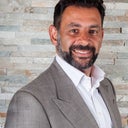Hi, I have performed many SMAS facelifts for over 30 years and have performed many minimally, invasive SMAS facelifts on women in their thirties. From the photos your cheeks are very flat in the front (more so on one side), jowls are present and the back portion of the jaw line is also weak. Better close up photos of the eyes would help differentiate lower eyelid fat bags from, malar bags or indentations in the tear troughs. These factors combine to create a long, thin, rectangularly shaped face.





